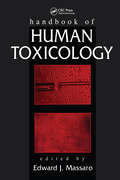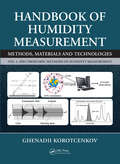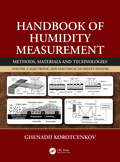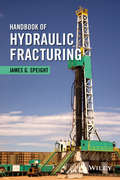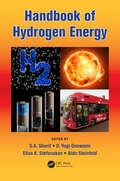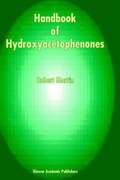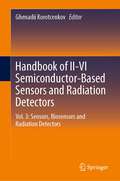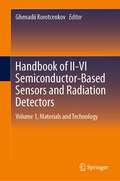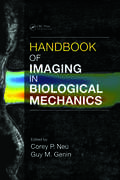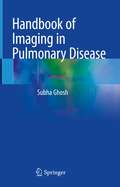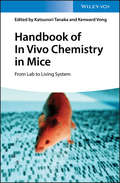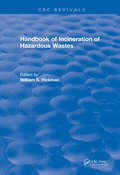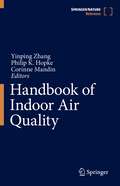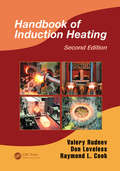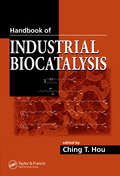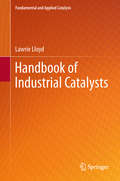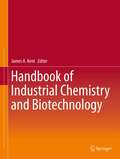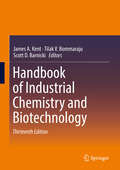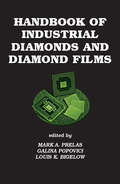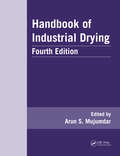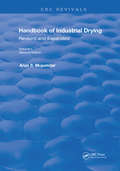- Table View
- List View
Handbook of Human Toxicology
by Edward J. MassaroCovering some of the most important topics in modern toxicology, the Handbook of Human Toxicology is a unique and valuable addition to the current literature. It addresses issues, answers questions, and provides data related to. Within each of these five major sections are several carefully selected topics that reflect the current state of human to
Handbook of Human and Planetary Health (Climate Change Management)
by Walter Leal FilhoThis book contains a set of papers which explore the subject matter of human and planetary health at various angles The year 2015 was a special year in the field of human and planetary health. In that year, the report, produced by the Rockefeller Foundation and the journal The Lancet, called “Safeguarding human health in the Anthropocene epoch: report of The Rockefeller Foundation-Lancet Commission on planetary health” was launched. Also in 2015, the World Health Organization and the Secretariat of the Convention on Biological Diversity published the report “Connecting global priorities: biodiversity and human health: a state of knowledge review” with over 100 contributors, meant to guide future joint actions. Both documents comprehensively address the need for a better understanding of the connections between human health and ecosystems and the risks associated with damages to the integrity of the planet. The period in which humanity finds itself right now, the Anthropocene, is a risk one since mankind is putting the planet under considerable pressure. These elements have led to the emergence of a new field of research, namely planetary health. Planetary health seeks to address a very concrete and urgent contemporary problem, namely the need to understand, quantify, and act in order to reverse the effects of human population growth and the acceleration of socioeconomic activities on the environment and, inter alia, the disturbances in the Earth's natural ecosystems and how these, in turn, impact human health and well-being. Anthropic disturbances in natural ecosystems are characterized by changes in climate, land use, changes in the nitrogen and phosphorus cycle, chemical pollution of soil, water and air, reduction in the availability of drinking water, loss of biodiversity, destruction of the ozone layer, and ocean acidification, among others. In all these areas, there is a perceived need to document and promote examples of initiatives and good practice, which may change current trends. This book addresses this need. It documents experiences, case studies, and projects which explore the connections between human and planetary health and illustrates examples which show the consequences of ecosystemic disturbances to the health and well-being of humanity, with the emergence of new diseases, worsening of infectious diseases and increase in chronic non-communicable diseases related to the deterioration of the current food system, hyper-urbanization, microbial resistance, climate-led migration and zoonoses, among others. Planetary health is a new effort to deal with the question of sustainability and human life on the planet under an increasingly integrative, transdisciplinary, and global perspective, since the problems of this planetary crisis cross geopolitical borders and academic boundaries and affect humanity as a whole. This book provides a contribution to this emerging field. Thanks to its design and the contributions by experts from various areas, it provides a welcome contribution to the literature on planetary health, and it inspires further works in this field.
Handbook of Humidity Measurement, Volume 1: Spectroscopic Methods of Humidity Measurement
by Ghenadii KorotcenkovThe first volume of The Handbook of Humidity Measurement focuses on the review of devices based on optical principles of measurement such as optical UV, fluorescence hygrometers, optical and fiber-optic sensors of various types. Numerous methods for monitoring the atmosphere have been developed in recent years, based on measuring the absorption of electromagnetic field in different spectral ranges. These methods, covering the optical (FTIR and Lidar techniques), as well as a microwave and THz ranges are discussed in detail in this volume. The role of humidity-sensitive materials in optical and fiber-optic sensors is also detailed. This volume describes the reasons for controlling the humidity, features of water and water vapors, and units used for humidity measurement.
Handbook of Humidity Measurement, Volume 2: Electronic and Electrical Humidity Sensors
by Ghenadii KorotcenkovBecause of unique water properties, humidity affects many living organisms, including humans and materials. Humidity control is important in various fields, from production management to creating a comfortable living environment. The second volume of The Handbook of Humidity Measurement is entirely devoted to the consideration of different types of solid-state devices developed for humidity measurement. This volume discusses the advantages and disadvantages about the capacitive, resistive, gravimetric, hygrometric, field ionization, microwave, Schottky barrier, Kelvin probe, field-effect transistor, solid-state electrochemical, and thermal conductivity-based humidity sensors. Additional features include: Provides a comprehensive analysis of the properties of humidity-sensitive materials, used for the development of such devices. Describes numerous strategies for the fabrication and characterization of humidity sensitive materials and sensing structures used in sensor applications. Explores new approaches proposed for the development of humidity sensors. Considers conventional devices such as phsychometers, gravimetric, mechanical (hair), electrolytic, child mirror hygrometers, etc., which were used for the measurement of humidity for several centuries. Handbook of Humidity Measurement, Volume 2: Electronic and Electrical Humidity Sensors provides valuable information for practicing engineers, measurement experts, laboratory technicians, project managers in industries and national laboratories, as well as university students and professors interested in solutions to humidity measurement tasks as well as in understanding fundamentals of any gas sensor operation and development.
Handbook of Humidity Measurement, Volume 3: Sensing Materials and Technologies
by Ghenadii KorotcenkovBecause of unique water properties, humidity affects materials and many living organisms, including humans. Humidity control is important in various fields, from production management to creating a comfortable living environment. The range of materials that can be used in the development of humidity sensors is very broad, and the third volume of the Handbook of Humidity Measurement offers an analysis on various humidity-sensitive materials and sensor technologies used in the fabrication of humidity sensors and methods acceptable for their testing. Additional features include: numerous strategies for the fabrication and characterization of humidity-sensitive materials and sensing structures used in sensor applications, methods and properties to develop smaller, cheaper, more robust, and accurate devices with better sensitivity and stability, a guide to sensor selection and an overview of the humidity sensor market, and new technology solutions for integration, miniaturization, and specificity of the humidity sensor calibration. Handbook of Humidity Measurement, Volume 3: Sensing Materials and Technologies provides valuable information for practicing engineers, measurement experts, laboratory technicians, project managers in industries and national laboratories, and university students and professors interested in solutions to humidity measurement tasks. Despite the fact that this book is devoted to the humidity sensors, it can be used as a basis for understanding fundamentals of any gas sensor operation and development.
Handbook of Hydraulic Fracturing
by James G. SpeightPresents an up-to-date description of current and new hydraulic fracturing processes Details Emerging Technologies such as Fracture Treatment Design, Open Hole Fracturing, Screenless Completions, Sand Control, Fracturing Completions and Productivity Covers Environmental Impact issues including Geological Disturbance; Chemicals used in Fracturing; General Chemicals; Toxic Chemicals; and Air, Water, Land, and Health impacts Provides many process diagrams as well as tables of feedstocks and their respective products
Handbook of Hydrocarbon and Lipid Microbiology
by Jan Roelof Meer Kenneth N. Timmis Terry Mcgenity Victor De LorenzoThis handbook provides a comprehensive overview of microbial interactions with the major forms of hydrocarbons, oils, and lipids in or entering the biosphere. It is the definitive resource on the physiological mechanisms and adaptive strategies characteristic of the microbial lifestyle that plays out at hydrophobic material: aqueous liquid interfaces.
Handbook of Hydrogen Energy (Mechanical and Aerospace Engineering Series)
by D. Yogi Goswami S. A. Sherif Aldo Steinfeld Elias K. StefanakosCan hydrogen and electricity supply all of the world's energy needs? Handbook of Hydrogen Energy thoroughly explores the notion of a hydrogen economy and addresses this question. The handbook considers hydrogen and electricity as a permanent energy system and provides factual information based on science. The text focuses on a large cross section o
Handbook of Hydroxyacetophenones
by Robert MartinThird Edition entitled Aromatic Hydroxyketones: Preparation and Physical Properties to be published in 2010 as a 4-volume handbook set including: Vol. 1: Hydroxybenzophenones Vol. 2: Hydroxyacetophenones I Vol. 3: Hydroxyacetophenones II Vol. 4: Hydroxypropiophenones, Hydroxyisobutyrophenones, Hydroxypivalophenones and Derivatives --------------- Hydroxyacetophenones constitute the starting material for a wide variety of syntheses in organic chemistry. They are versatile building blocks serving many different applications, such as specialty polymers, pharmaceuticals and fine chemicals. In this Handbook the diverse ways of obtaining over 3000 hydroxyacetophenones are described and their physico-chemical properties and spectroscopic data references are indicated. The Handbook is presented in dictionary style, with a logical classification of the ketones, making the information easily available for consultation. Ketones are classified methodically. They are thus easily accessible from three tables: - the molecular formula index - the chemical abstracts registry - the usual names index. This completely revised and enlarged edition includes: - 10 additional chapters compared with the previous edition which had just 2 chapters - an additional 1500 ketones - updated information for ~1200 ketone entries - the addition of di- and polyketones - approximately 3500 references. This Handbook is the reference on hydroxyacetophenones. It is a powerful synthesis tool for the researcher or industrial producers. Nowhere else are so many compounds covered or the physical properties and relevant syntheses provided. It provides a wide choice of hydroxyketones required to achieve syntheses based upon this range of intermediates.
Handbook of II-VI Semiconductor-Based Sensors and Radiation Detectors: Vol. 3: Sensors, Biosensors and Radiation Detectors
by Ghenadii KorotcenkovThe reference provides interdisciplinary discussion for diverse II-VI semiconductors with a wide range of topics. The third volume of a three volume set, the book provides an up-to-date account of the present status of multifunctional II-VI semiconductors, from fundamental science and processing to their applications as various sensors, biosensors, and radiation detectors, and based on them to formulate new goals for the further research. The chapters in this volume provide a comprehensive overview of the manufacture, parameters and principles of operation of these devices. The application of these devices in various fields such medicine, agriculture, food quality control, environment monitoring and others is also considered. The analysis carried out shows the great potential of II-VI semiconductor-based sensors and detectors for these applications.Considers solid-state radiation detectors based on semiconductors of II-VI group and their applications;Analyzes the advantages of II-VI compounds to develop chemical and optical gas and ion sensors; Describes all types of biosensors based on II-VI semiconductors and gives examples of their use in various fields.
Handbook of II-VI Semiconductor-Based Sensors and Radiation Detectors: Volume 1, Materials and Technology
by Ghenadii KorotcenkovThree-volumes book “Handbook of II-VI Semiconductor-Based Sensors and Radiation Detectors” is the first to cover both chemical sensors and biosensors and all types of photodetectors and radiation detectors based on II-VI semiconductors. It contains a comprehensive and detailed analysis of all aspects of the application of II-VI semiconductors in these devices. The first volume "Materials and Technologies" of a three-volume set describes the physical, chemical and electronic properties of II-VI compounds, which give rise to an increased interest in these semiconductors. Technologies that are used in the development of various devices based on II-VI connections, such as material synthesis, deposition, characterization, processing, and device fabrication, are also discussed in detail in this volume. It covers also topics related to synthesis and application of II-VI-based nanoparticles and quantum dots, as well their toxicity, biocompatibility and biofunctionalization.
Handbook of Imaging in Biological Mechanics
by Guy M. Genin Corey P. NeuEmerging imaging techniques have opened new fronts to investigate tissues, cells, and proteins. Transformative technologies such as microCT scans, super-resolution microscopy, fluorescence-based tools, and other methods now allow us to study the mechanics of cancer, dissect the origins of cellular force regulation, and examine biological specimens
Handbook of Imaging in Pulmonary Disease
by Subha GhoshThis book is a comprehensive and easy-to-read guide to pulmonary imaging. Medical Imaging is one of the cornerstones of modern medicine, and nowhere is this more apparent than pulmonary disease. We have come a long way from the days of chest radiography, though the chest radiograph still remains the single most common imaging test ordered worldwide. Pulmonary disease is now routinely evaluated with ultra-modern computed tomography (CT), magnetic resonance imaging (MRI) and positron emission tomography (PET) scanners, while ultrasonography plays a limited role in critical care and pleural/chest wall diseases. Rapid advancements in the sub-specialty of chest imaging and an exponential increase in the knowledge of pulmonary disease have led to an increasing demand for a comprehensive yet easily digestible handbook of pulmonary imaging, which prepackages knowledge in a form that can be easily understood and readily visualized with high-quality representative images.This book answers that need by providing the most important, relevant medical knowledge needed to handle pulmonary cases. It is divided into two sections, neoplastic disease and non-neoplastic disease. Chapters detail essential information about each disease, including presentation and the different modalities used to accurately diagnose and/or plan treatment. Major topics that are covered include bronchogenic carcinoma and other lung tumors, COPD, ILD, developmental lung disorders, pulmonary hypertension, and pulmonary infections. Each chapter includes extensive radiographic images to give a complete perspective on how these diseases present. Readers can easily see what the radiology of a particular disease entity looks like, what would be the differential diagnoses for a particular imaging abnormality, and compare the bullet review points associated with an image to their particular case.This is an ideal guide for general and thoracic radiologists, pulmonary, sleep medicine, and critical care specialists, thoracic surgeons, as well as residents and all clinicians who treat patients with pulmonary disease.
Handbook of In Vivo Chemistry in Mice: From Lab to Living System
by Katsunori Tanaka Kenward VongProvides timely, comprehensive coverage of in vivo chemical reactions within live animals This handbook summarizes the interdisciplinary expertise of both chemists and biologists performing in vivo chemical reactions within live animals. By comparing and contrasting currently available chemical and biological techniques, it serves not just as a collection of the pioneering work done in animal-based studies, but also as a technical guide to help readers decide which tools are suitable and best for their experimental needs. The Handbook of In Vivo Chemistry in Mice: From Lab to Living System introduces readers to general information about live animal experiments and detection methods commonly used for these animal models. It focuses on chemistry-based techniques to develop selective in vivo targeting methodologies, as well as strategies for in vivo chemistry and drug release. Topics include: currently available mouse models; biocompatible fluorophores; radionuclides for radiodiagnosis/radiotherapy; live animal imaging techniques such as positron emission tomography (PET) imaging; magnetic resonance imaging (MRI); ultrasound imaging; hybrid imaging; biocompatible chemical reactions; ligand-directed nucleophilic substitution chemistry; biorthogonal prodrug release strategies; and various selective targeting strategies for live animals. -Completely covers current techniques of in vivo chemistry performed in live animals -Describes general information about commonly used live animal experiments and detection methods -Focuses on chemistry-based techniques to develop selective in vivo targeting methodologies, as well as strategies for in vivo chemistry and drug release -Places emphasis on material properties required for the development of appropriate compounds to be used for imaging and therapeutic purposes in preclinical applications Handbook of In Vivo Chemistry in Mice: From Lab to Living System will be of great interest to pharmaceutical chemists, life scientists, and organic chemists. It will also appeal to those working in the pharmaceutical and biotechnology industries.
Handbook of Incineration of Hazardous Wastes (CRC Press Revivals)
by William S. RickmanHazardous waste incineration technologies have been developed to meet the needs of a rapidly growing market that has been created by the proliferation of hazardous waste in modern society. These hazardous wastes are continuously produced as by-products of many industries. Vast stockpiles of hazardous or toxic wastes are currently residing in insecure landfills, thus imperiling our drinking water supplies. This handbook is written with the user in mind. An in-depth review of regulatory and technical requirements is presented with later sections regarding permitting and operation of incineration facilities. A comprehensive description of established and emerging incinerator technologies is included along with a number of alternatives. One of the key sections involves a detailed procedure for choosing an incinerator for a specific job, including engineering calculations and going through the bid process. Rationale for whether to buy or lease incineration equipment is included as well as details on trial burns, permitting strategies, and startup and operation of incinerators. A number of typical case histories of incinerators are presented for such diverse applications as cleaning up individual sites with transportable units, stationary facilities for in-house wastes, and incinerator ships. Appendices provide a convenient reference to physical properties, combustion parameters, detailed equipment performance nomographs and several sample permits including RCRA, TSCA and local permit applications. In summary, this handbook provides a single reference point for the potential user of an incinerator as well as a valuable source of design data for incinerator vendors, consultants and regulators.
Handbook of Indoor Air Quality
by Yinping Zhang Philip K. Hopke Corinne MandinPeople live in indoor environment about 90% of lifetime and an adult inhales about 15 kg air each day, over 75% of the human body’s daily mass intake (air, food, water). Therefore, indoor air quality (IAQ) is very important to human health. This book provides the basic knowledge of IAQ and highlights the research achievements in the past two decades. It covers the following 12 sections: introduction, indoor air chemicals, indoor air particles, measurement and evaluation, source/sink characteristics, indoor chemistry, human exposure to indoor pollutants, health effects and health risk assessment, IAQ and cognitive performance, standards and guidelines, IAQ control, and air quality in various indoor environments. It provides a combination of an introduction to various aspects on IAQ studies, the current state-of-knowledge, various advances and the perspective of IAQ studies. It will be very helpful for the researchers and technicians in the IAQ and the related fields. It is also useful for experts in other fields and general readers who want to obtain a basic understanding of and research advances in the field of IAQ.A group of experts in IAQ research have been recruited to write the chapters. Their research interests and experience cover the scope of the book. In addition, some experienced experts in IAQ field have been invited as advisors or reviewers to give their comments, suggestions and revisions on the handbook framework and the chapter details. Their contribution guarantees the quality of the book. We are very grateful to them. Last but not least, we express our heartfelt thanks to Prof. Spengler, Harvard University, for writing the foreword of the current Handbook of Indoor Air Quality both as a pioneer scientist who contributed greatly to indoor air science and as an Editor-in-chief of Handbook of Indoor Air Quality 2001, 1st ed. New York: McGraw-Hill. In addition to hard copies, the book is also published online and will be updated by the authors as needed to keep it aligned with current knowledge. These salient features can make the handbook fresh with the research development.
Handbook of Induction Heating (Manufacturing Engineering and Materials Processing)
by Valery Rudnev Don Loveless Raymond L. CookThe second edition of the Handbook of Induction Heating reflects the number of substantial advances that have taken place over the last decade in theory, computer modeling, semi-conductor power supplies, and process technology of induction heating and induction heat treating. This edition continues to be a synthesis of information, discoveries, and technical insights that have been accumulated at Inductoheat Inc. With an emphasis on design and implementation, the newest edition of this seminal guide provides numerous case studies, ready-to-use tables, diagrams, rules-of-thumb, simplified formulas, and graphs for working professionals and students.
Handbook of Industrial Biocatalysis
by Ching T. HouUntil now, no comprehensive handbook on industrial biocatalysis has been available. Soliciting chapters on virtually every aspect of biocatalysis from international experts most actively researching the field, the Handbook of Industrial Biocatalysis fills this need. The handbook is divided into three sections based on types of substrates. T
Handbook of Industrial Catalysts
by Lawrie LloydMuch has been written about fundamental aspects of catalysis, yet despite their universal applications details concerning commercial catalysts and information about actual operating conditions are not readily available. This book provides up-to-date reviews and references to guide those working on industrial catalysts. It will be an invaluable guide for catalysis researchers in industry and academia, and for students.
Handbook of Industrial Chemistry and Biotechnology
by James A. KentSubstantially revising and updating the classic reference in the field, this handbook offers a valuable overview and myriad details on current chemical processes, products, and practices. No other source offers as much data on the chemistry, engineering, economics, and infrastructure of the industry. The Handbook serves a spectrum of individuals, from those who are directly involved in the chemical industry to others in related industries and activities. It provides not only the underlying science and technology for important industry sectors, but also broad coverage of critical supporting topics. Industrial processes and products can be much enhanced through observing the tenets and applying the methodologies found in chapters on Green Engineering and Chemistry (specifically, biomass conversion), Practical Catalysis, and Environmental Measurements; as well as expanded treatment of Safety, chemistry plant security, and Emergency Preparedness. Understanding these factors allows them to be part of the total process and helps achieve optimum results in, for example, process development, review, and modification. Important topics in the energy field, namely nuclear, coal, natural gas, and petroleum, are covered in individual chapters. Other new chapters include energy conversion, energy storage, emerging nanoscience and technology. Updated sections include more material on biomass conversion, as well as three chapters covering biotechnology topics, namely, Industrial Biotechnology, Industrial Enzymes, and Industrial Production of Therapeutic Proteins.
Handbook of Industrial Chemistry and Biotechnology
by James A. Kent Tilak V. Bommaraju Scott D. BarnickiSubstantially revising and updating the classic reference in the field, this handbook offers a valuable overview and myriad details on current chemical processes, products, and practices. No other source offers as much data on the chemistry, engineering, economics, and infrastructure of the industry. The Handbook serves a spectrum of individuals, from those who are directly involved in the chemical industry to others in related industries and activities. It provides not only the underlying science and technology for important industry sectors, but also broad coverage of critical supporting topics. Industrial processes and products can be much enhanced through observing the tenets and applying the methodologies found in chapters on Green Engineering and Chemistry (specifically, biomass conversion), Practical Catalysis, and Environmental Measurements; as well as expanded treatment of Safety, chemistry plant security, and Emergency Preparedness. Understanding these factors allows them to be part of the total process and helps achieve optimum results in, for example, process development, review, and modification. Important topics in the energy field, namely nuclear, coal, natural gas, and petroleum, are covered in individual chapters. Other new chapters include energy conversion, energy storage, emerging nanoscience and technology. Updated sections include more material on biomass conversion, as well as three chapters covering biotechnology topics, namely, Industrial Biotechnology, Industrial Enzymes, and Industrial Production of Therapeutic Proteins.
Handbook of Industrial Crystallization
by Allan S. Myerson Deniz Erdemir Alfred Y. LeeLearn from the experts about industrial crystallization in this third edition of a widely regarded classic that has been completely revised to reflect the latest developments in the field. New chapters on crystal nucleation, molecular modelling application, and precipitation and crystallization of pigments and dyes are included, as well as completely revised chapters on crystallization of proteins, crystallizer selection and design, control of crystallization processes, and process analytical technology. Richly illustrated with 150 new diagrams and photographs, and with dozens of practical hands-on examples, this is an ideal introduction for newcomers, and serves as an excellent reference for experienced professionals covering aspects of industrial crystallization in a single, complete volume.
Handbook of Industrial Diamonds and Diamond Films
by Mark A. Prelas Galina Popovici Louis K. BigelowExamines both mined and synthetic diamonds and diamond films. The text offers coverage on the use of diamond as an engineering material, integrating original research on the science, technology and applications of diamond. It discusses the use of chemical vapour deposition grown diamonds in electronics, cutting tools, wear resistant coatings, thermal management, optics and acoustics, as well as in new products.
Handbook of Industrial Drying (ISSN)
by Arun S. MujumdarBy far the most commonly encountered and energy-intensive unit operation in almost all industrial sectors, industrial drying continues to attract the interest of scientists, researchers, and engineers. The Handbook of Industrial Drying, Fourth Edition not only delivers a comprehensive treatment of the current state of the art, but also serves as a
Handbook of Industrial Drying: Second Edition, Revised and Expanded (Routledge Revivals #1)
by Arun S. MujumdarFirst Published in 1995, this book offers a full guide into industrial drying for various materials. Carefully compiled and filled with a vast repertoire of notes, diagrams, and references this book serves as a useful reference for students of medicine and other practitioners in their respective fields.
